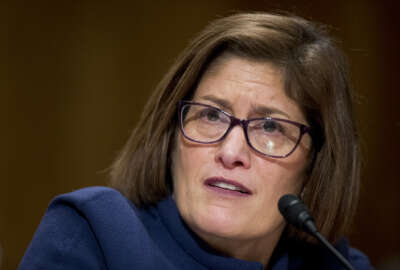
Obama administration looks back on management successes
Two weeks before President-elect Donald Trump takes office, the Obama administration has highlighted some of the management milestones it's achieved over the la...
 Two weeks before President-elect Donald Trump takes office, the Obama administration has highlighted some of the management milestones it’s achieved over the last eight years, and demonstrated where to go from here.
Two weeks before President-elect Donald Trump takes office, the Obama administration has highlighted some of the management milestones it’s achieved over the last eight years, and demonstrated where to go from here.
In a series of “exit memos” addressed to the American public, Obama and his Cabinet secretaries have outlined where federal agencies have made the most progress.
Obama’s farewell memo to the public touched on broader issues like the economy and the fight against the Islamic State militants, but said little about the achievements of the federal workforce. On Dec. 13, he delivered a “thank you” address to federal employees, just days after increasing the 2017 pay raise for civilian agency employees 2.1 percent.
“This is where America stands after eight years of progress. By so many measures, our country is stronger and more prosperous than it was when we started — a situation I’m proud to leave for my successor,” Obama said.
In addition to his own address, the President also instructed 27 federal agency leaders to submit their own exit memos outlining their management and mission achievements. Here are just a few of the highlights:
Defense Department
 In his memo to the President, Defense Secretary Ash Carter mentioned the Pentagon’s improvements in its cyber policy. Over the past four years, DoD has increased its budget request by more than 50 percent, going from $4.6 million to $6.8 billion.
In his memo to the President, Defense Secretary Ash Carter mentioned the Pentagon’s improvements in its cyber policy. Over the past four years, DoD has increased its budget request by more than 50 percent, going from $4.6 million to $6.8 billion.
“We’ve moved to a culture of accountability in cyberspace, instituting a DoD-wide cybersecurity scorecard and improving knowledge about practical ways to defend against cyber intrusions,” Carter said.
DoD also touted its “Hack the Pentagon” initiative, the government’s first-ever “bug bounty” program, which invited white-hat hackers probe Defense websites for security vulnerabilities. The Pentagon announced in June that it completed 138 patches that were discovered during the bug bounty. The Pentagon has already planned on expanding the program.
Homeland Security Department
 In his memo, Homeland Security Secretary Jeh Johnson outlined his agency’s successes in the cybersecurity domain. He pointed to the rapid growth of the National Cybersecurity and Communications Integration Center (NCCIC), which communicates cyber threats to 12 other federal agencies.
In his memo, Homeland Security Secretary Jeh Johnson outlined his agency’s successes in the cybersecurity domain. He pointed to the rapid growth of the National Cybersecurity and Communications Integration Center (NCCIC), which communicates cyber threats to 12 other federal agencies.
Johnson also touted the success of EINSTEIN 3A, which detects and monitors cyber intrusions on federal civilian networks. According to the memo, more than 80 percent of federal civilian networks have adopted EINSTEIN 3A. Under the Cybersecurity Act of 2015, DHS was instructed to move all large agencies under the program.
DHS also made note of its Continuous Diagnostics and Mitigation program, which currently detects networks vulnerabilities in 97 percent of civilian agencies.
Looking ahead to the future, Johnson said the agency has made some progress in hiring new cyber talent. Working with the Office of Personnel Mangement, DHS held its first cyber and tech job fair in July. Within 60 days of the job fair, it brought on 120 new cybersecurity employees.
“We have made tangible improvements to the nation’s cybersecurity, but more work remains to be done,” Johnson said.
Veterans Affairs
 The Veterans Affairs Department has faced widespread criticism for its handling of patient wait times since 2014. Looking back at his tenure at VA, Secretary Bob McDonald said the agency has made a major overhaul in how veterans receive medical care.Since I arrived in late 2014, our leadership team has been turning crisis into a once-in-a-generation opportunity to transform VA,” McDonald said.
The Veterans Affairs Department has faced widespread criticism for its handling of patient wait times since 2014. Looking back at his tenure at VA, Secretary Bob McDonald said the agency has made a major overhaul in how veterans receive medical care.Since I arrived in late 2014, our leadership team has been turning crisis into a once-in-a-generation opportunity to transform VA,” McDonald said.
By September 2016, 96.5 percent of VA appointments were completed within 30 days of the patient’s preferred date. According to the memo, the average wait time for primary care is around five days, six for specialty care, and two for mental health care.
General Services Administration
 The General Services Administration, already deep in the planning stages of a new headquarters for the FBI, has made significant improvements in reducing the federal government’s office space footprint.
The General Services Administration, already deep in the planning stages of a new headquarters for the FBI, has made significant improvements in reducing the federal government’s office space footprint.
Under the Obama administration, GSA reduced federal real property by 24.7 million square feet, a more than $300 million cost savings.
“By reducing and modernizing our property, we have produced workplaces that allow agencies to better collaborate and recruit top talent. This allows agencies to increase performance and better achieve their missions at lower cost,” said GSA Administrator Denise Turner Roth.
Office of Management and Budget
 With a nod to Federal CIO Tony Scott’s push for IT modernization, OMB Director Shaun Donovan touted Obama’s focus on improving the way the public interacts with government services online.
With a nod to Federal CIO Tony Scott’s push for IT modernization, OMB Director Shaun Donovan touted Obama’s focus on improving the way the public interacts with government services online.
“Over the past eight years through the President’s Management Agenda, OMB has led the Administration’s successful efforts to modernize and improve citizen-facing services, reform the way we buy and operate information technology in the 21st century, eliminate wasteful spending, reduce the Federal real property footprint, and help spur innovation in the private sector,” he said.
View the full list of Cabinet exit memos at WhiteHouse.gov
Copyright © 2024 Federal News Network. All rights reserved. This website is not intended for users located within the European Economic Area.
Jory Heckman is a reporter at Federal News Network covering U.S. Postal Service, IRS, big data and technology issues.
Follow @jheckmanWFED



